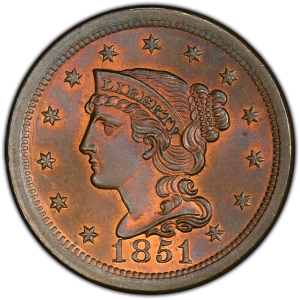

Ron Guth: Braided Hair large cents first appeared in 1839 as a modification to the old Matron head design. The most obvious difference between the two, besides the shape of the head, is the braiding of the hair from Liberty’s ear to her forehead. By 1839, the technical skills of the mint employees had improved to the point where differences in individual dies were almost microscopic in detail, as opposed to the gross differences on earlier Large Cents (for example: stemless wreaths, mis-numbered stars, incorrect fractions, etc.). Even so, researchers such as Howard Newcomb and Bob Grellman have identified all of the known die varieties for an enthusiastic crowd of collectors. A date set of Braided Hair cents can be completed with ease and many of the individual dates can be found in Mint State condition, often with partial or full red color. Interesting varieties include the Silly Head and Booby Head of 1839, the 1839/6, the 1851/81, the 1855 “Knob on Ear” and the Large and Small Dates of 1857.
No large cents were struck after 1857. They, and the half cents, simply became too expensive to produce any longer.
Sources and/or recommended reading:
“Attribution Guide For United States Large Cents 1840-1857”, 2nd edition by J.R. Grellman and Jules Reiver.

